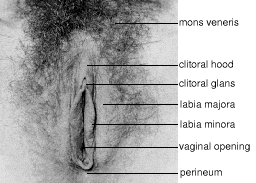Vulva

The external genital organs of the female are collectively known as the vulva (also sometimes called the pudenda).
In human beings this consists of the labia majora and labia minora (while these names translate as "large" and "small" lips, often the "minora" can be larger, and protrude outside the "majora"), clitoris, opening of the urethra (meatus), and the opening of the vagina. The main functions involving the vulva are urination, sexual behavior, menstruation, and childbirth.
(In common speech, the term "vagina" is often used improperly to refer to the vulva or female genitals generally, even though strictly speaking the vagina is a specific internal structure and the vulva is the exterior genitalia only. Calling the vulva the vagina is akin to calling the mouth the throat.)
Contents[hide] |
Description
The soft mound at the front of the vulva is the mons pubis, or specifically for humans, the mons veneris or "mount of Venus". After puberty it is covered with pubic hair to some extent, the amount being determined primarily by heredity. The labia majora or large lips extend on either side of the vulva, and may also be covered with pubic hair. The labia majora entirely or partially hide the other parts of the vulva. The colour of the outside skin of the labia majora is usually close to the overall skin colour of the individual, although there is considerable variation. The inside skin is often pink or brownish.
The labia minora are two soft folds of skin within the labia majora and to either side of the opening of the vagina. The clitoris is at the front of the vulva where the labia minora meet. The visible tip of the clitoris, the clitoral glans is entirely or partially covered by a 'hood' of tissue (the clitoral hood).
The opening of the vagina is near the back (or bottom) end of the vulva; the much smaller opening of the urethra is between the clitoris and vagina. In young girls, the opening of the vagina is partially covered by a piece of skin, the hymen. "Opening of the vagina" is something of a misnomer, as the vagina is normally not open but collapsed and the walls of the vagina touch.
Slightly below and to the left and right of the vaginal opening are two Bartholin glands; when the woman is sexually aroused, they produce a lubricating substance that makes sexual penetration easier (the vagina also exudes vaginal lubrication). If this lubrication is insufficient, artificial lubrication may be used to facilitate sexual intercourse.
The area between the vulva and the anus is the perineum.
The appearance of the vulva and the size of the various parts varies a great deal from one woman to another, and it is common for the left and right sides to not "match" exactly in an individual woman.
Relation to male genitals
The anatomy of the vulva is related to the anatomy of the male genitalia by a common developmental biology. Organs that have a common developmental ancestry in this way are said to be homologous.
The clitoral glans is homologous to the glans penis in males, and the body of the clitoris, or the crura, is homologous to the corpora cavernosa of the penis. The labia majora, labia minora and clitoral hood are homologous to the scrotum, shaft skin of the penis, and the foreskin, respectively. The vestibular bulbs beneath the skin of the labia minora are homologous to the corpus spongiosum, the tissue of the penis surrounding the urethra. The Bartholin's glands are homologous to Cowper's glands in males.
Conception
Heterosexual couples wishing to avoid pregnancy should note that conception is possible if semen comes in contact with the vulva (even through underwear) because the sperm can be introduced into the vagina by capillary action. Furthermore, if penetration occurs but ejaculation never takes place, pregnancy can still result.
Cultural attitudes
In many cultures, including modern Western culture, some women have shaved or otherwise depilated part or all of the vulva.
Many cultures have commonly viewed the vulva as something shameful that should be hidden; the term pudendum literally means "shameful thing." However, in some other cultures it has been celebrated and even worshipped. In some Hindu sects the vulva is revered under the name yoni, and texts seem to indicate a similar attitude in some ancient Middle Eastern religions. As an aspect of Goddess worship such reverence may be part of modern Neopagan or Wiccan beliefs, and may be indicated in paleolithic artworks. Some cultures consider the vulva to be "unclean" and go as far as to advocate female circumcision.
In the past many sculptors and painters chose not to display vulvas in their works, even when depicting nude women. The pubic region was often covered with a piece of cloth, fig leaf or a hand. When it was displayed, it usually lacked pubic hair and the vulva, even though the vulva would be visible on a real woman in that particular pose. In modern times Japanese anime artists often depict female characters without vulvas (even in hentai pornography) to comply with censorship laws. Because for most of history vulvas were neither displayed by women, nor shown in art, aesthetic standards for the vulva in the West developed after visual pornography became more widespread.
See also
External links
- Anatomy of the vulva 1, or Anatomy of the vulva 2 and click on 'Body image', then 'The Vulva revealed', for extensive descriptions, numerous illustrations showing the large variations among women
- Web site containing many illustrations of sexual anatomy
- Vagina Institute A commercial website with (somewhat unscientific) statistics on vaginas.
